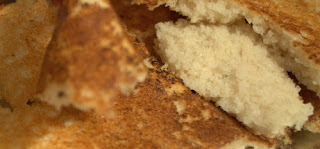Nammamma makes kootu with different vegetables but there is always a well defined combination such as balekayi(raw/green banana)-alasande kalu (black eyed beans), balekayi-badane kayi(brinjal/eggplant), southekayi (cucumber), mixed vegetables (beans, carrot, raw banana) among others. The consistency of the end product varies based on the vegetables combo, some tend to be naturally thick while others are more watery. Though kootu tends to have cooked dal - typically togari bele (Tuvar dal/split red gram), I avoid it if I am using whole grains or other pulses as you already have your share of proteins in it.
I love balekayi or raw bananas or plantains, I know I say it for all vegetables :-), I am a veggie girl. I really don't have any vegetables on my 'not like' list. Yes, I do have my preferences and it changes based on the season :-). We had banana plants at home in Mysore but nammamma would make sure they were of the variety you eat after it is ripe, usually the small, sweet elakki bale kind and not the green variety because she thought it will be a waste having a full bunch of green bananas. I remember my doddamma had a green banana plant in her back yard when we visited them in Erode in Tamil Nadu long time ago. She lived in a colony and had regular kitty parties with her huge group of friends. They used to make yummy, hot balekayi bajjis (raw banana fritters) in the afternoons with the fresh picked green bananas from the backyard.
We like spicy, warm dishes during the cold winter months, I tend to make a lot of soups, kootu, one pot spicy rice dishes like pongal & khichdi and have it with roasted papads. This is one such meal when I found fresh green bananas in the grocery store.
This picture is from my Akka's backyard of her banana plant, this is a ripe fruit variety also. They had to support the big 'go-ney'(bunch of bananas) with 2 poles as it was heavy and lugging the poor plant with it to the ground.
What do you need to make Balekayi kootu?
2 fresh raw bananas - peeled and chopped into 1 inch pieces (see pic)
1 cup black eyed peas/alasande kalu/lobhia (soaked in hot water for 2 hours or soaked in cold water for 4-5 Hrs)
4-6 curry leaves
1 Tblsp salt (adjust to taste)
1/2 Tsp turmeric powder
2 Tblsp milk (I used 2%)
water
For the masala:
1 Tsp chana dal/kadle bele
1 Tsp cumin seeds/jeerige
1/2 Tsp coriander seeds/dhania
1 Tsp black pepper corns (adjust to heat tolerance)
1 red chili broken into two
2 Tblsp grated coconut (fresh/frozen)
1 Tsp cooking oil or ghee/clarified butter
How do you make Balekayi kootu?
- Cook the soaked black eyed peas until it is soft but holds shape.
- Cook the raw bananas until it is soft to touch.
- Mix the bananas & cooked peas.
- Heat the ghee/oil and roast all ingredients listed under masala except for the coconut until the dal turns light brown and a nice aroma envelops you in the kitchen.
- Let the masala ingredients cool to room temperature and grind it with the coconut & 2 Tblsp of cooked peas into a smooth paste by adding water.
- Add the ground mixture to the cooked vegetable, adjust water to the consistency of choice and bring to a boil.
- Tear the curry leaves and drop it into the boiling mixture.
- Add the milk and let it boil for a few minutes, switch off.
Variations:
- As I mentioned above, you can make kootu with other vegetable combinations but make sure match the crunch, taste of the veggies before mixing them. Traditionally, kootu never has veggies such as radish/mulangi, ladies finger/okra/bendekayi which have unique taste of texture. Kootu should have the over powering flavor of roasted pepper and cumin.
Tips:
- Choose fresh raw bananas for best taste, if they are already limp when you get them home, make something else like cutlets where it gets mashed into a pulp anyways :-).
- Start cooking the black eyed peas in a big vessel and add the banana pieces when it is 10 minutes into cooking process, they both tend to cook fast and will be ready together.
- Do not cook the raw banana in pressure cooker unless you know your pressure cooker really well, one additional minute will render completely mashed bananas which is no good for the kootu. I prefer open vessel cooking for this recipe where I can control the cook time.
- Adding the cooked peas into the masala gives it body and makes the kootu thick, you can skip this if you want a flowy consistency to the kootu.




















































